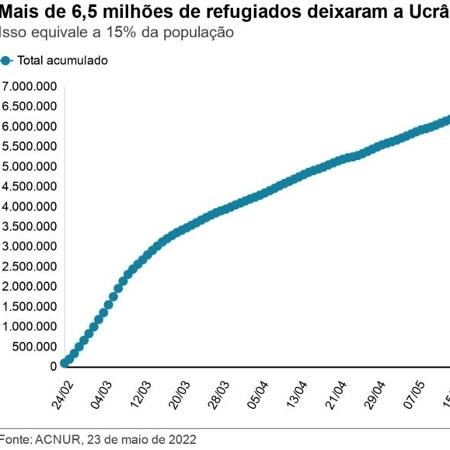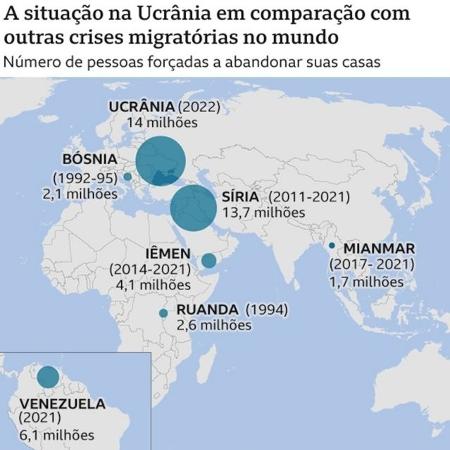Thursday, February 24. Europe is waking up with an announcement: “Special Military Operation” in Ukraine.
This was a euphemism used by Russian President Vladimir Putin to refer to the invasion of the neighboring country. After the message broadcast on television, the first explosions began to be heard on the territory of Ukraine.
The previous weeks had been tense. The summit came after Putin recognized the independence of the Donetsk and Luhansk rebel areas and ordered the deployment of troops in the region.
This conflict has its origins in 2014, when Russia annexed Ukraine’s Crimean peninsula and backed separatist forces in eastern Ukraine. Then there were clashes between pro-Russian separatists and Ukrainian forces in that region. By then this conflict had killed 14,000 people.
There has been no ceasefire in Ukraine for the past three months.
These maps show how the war developed during this period.

Image: Playback/BBC
Days before Putin announced the operation to “disarm and naziify Ukraine”, the president had sent Russian troops to the Donetsk and Lugansk regions.
Russia invaded Ukraine on February 24 and in mid-March occupied the north and areas close to the capital, Kiev.
Then Ukrainian forces recaptured large areas around Kyiv in early April, and Russia abandoned its offensive on the capital.
After Russia withdrew from the north of Ukraine, it redirected its efforts to take control of the east and south of the country.
In the south, Russian forces initially made quick gains to create a land corridor between the Crimea and Russian-backed separatist-held areas in Donetsk and Lugansk.
Still, the resistance of the Ukrainian forces slowed the Russian advance, especially in the west near Mykolaiv and in Mariupol. In the end, Russia managed to take Mariupol.

Image: Playback/BBC
Russian invasion of Donbas
After a series of defeats near Kyiv, Russia withdrew its troops from the Ukrainian capital. His initial goal seemed to be to take over the entire country and overthrow the Ukrainian government, but his strategy had to be realigned.
Thus, Russia shifted the weight of its field operations to eastern Ukraine, to the Donbas, where the conflict began in February.
Donbas is Ukraine’s former coal and steel producing region. It covers two large eastern regions, Luhansk and Donetsk, stretching from the outskirts of Mariupol in the south to its northern border.
Ukrainian Foreign Minister Dmytro Kuleba described the war in Donbas as World War II, in which “thousands of tanks, armored vehicles, planes and artillery participated”.

Image: Playback/BBC
number of refugees
NATO Secretary General Jens Stoltenberg recently said that Russia’s invasion of Ukraine will not go as the Russians planned, and Moscow’s attempt to seize eastern Donbas is “stagnant”.
The drama, perhaps most visible, is that of the millions of Ukrainians and residents of the country forced to flee for their lives from one day to the next.
Among the internally displaced, those traveling to safer areas of Ukraine, and those leaving the country, an estimated 14 million people left their homes, according to UN data.
About 8 million are displaced in the country. About 6 million people went to neighboring countries, especially to the west.
The pace of refugees leaving Ukraine has slowed in recent days. The UN says that as of May 17, 1.8 million Ukrainians have returned to the country. This is partly due to the fact that Ukrainian regions, such as the capital, Kyiv, that were threatened by Russian military advances earlier in the war, are now considered safer.

Image: Playback/BBC
Poland, Romania and Hungary were the countries receiving the most refugees on Ukraine’s western border.
Poland, which receives the most refugees, and Moldova, which has the highest density of refugees relative to its population, sought international support to fund its efforts.
Poland, Hungary and Slovakia have become transitional zones for other parts of the European Union. For example, there are more than 700,000 Ukrainians in Germany and 40% of them are children.
- What is the truth behind the laser weapons declared by Russia?
- War in Ukraine: The 80-day siege of Mariupol devastated the city
The EU granted Ukrainians the right to stay and work in its 27 member states for up to three years. They are entitled to welfare payments and access to housing, medical treatment and schools.
The Czech Republic has issued about 350 thousand emergency visas to Ukrainian refugees.
There were also movements from northern Ukraine to Belarus and eastwards from the pro-Russian separatist areas Lugansk and Donetsk to Russia.

Image: Playback/BBC
According to data from the UN Refugee Agency (UNHCR), the entry and exit of Ukrainian refugees in these three months represents the largest migration movement in the region.
Behind this is the war in Bosnia and Herzegovina, which has displaced more than 2 million people in three years. This is closely followed by the war in Syria, where 10 years of conflict have driven 13.7 million people from their homes.
In Latin America, UNHCR estimates that 6.1 million refugees and asylum seekers have left Venezuela in recent years.
No official data
So far, there are no updated figures from independent sources on the death toll in the quarterly conflict.
On May 13, Ukraine claimed to have killed about 20,000 Russian soldiers. Russia has not updated the death toll since March 25, when it acknowledged 1,351 deaths.
The UK Ministry of Defense estimates that Russia has lost about a third of its ground combat strength since the start of the war in February. The British government says a combination of factors led to many casualties, including poor tactics and limited air coverage.
source: Noticias